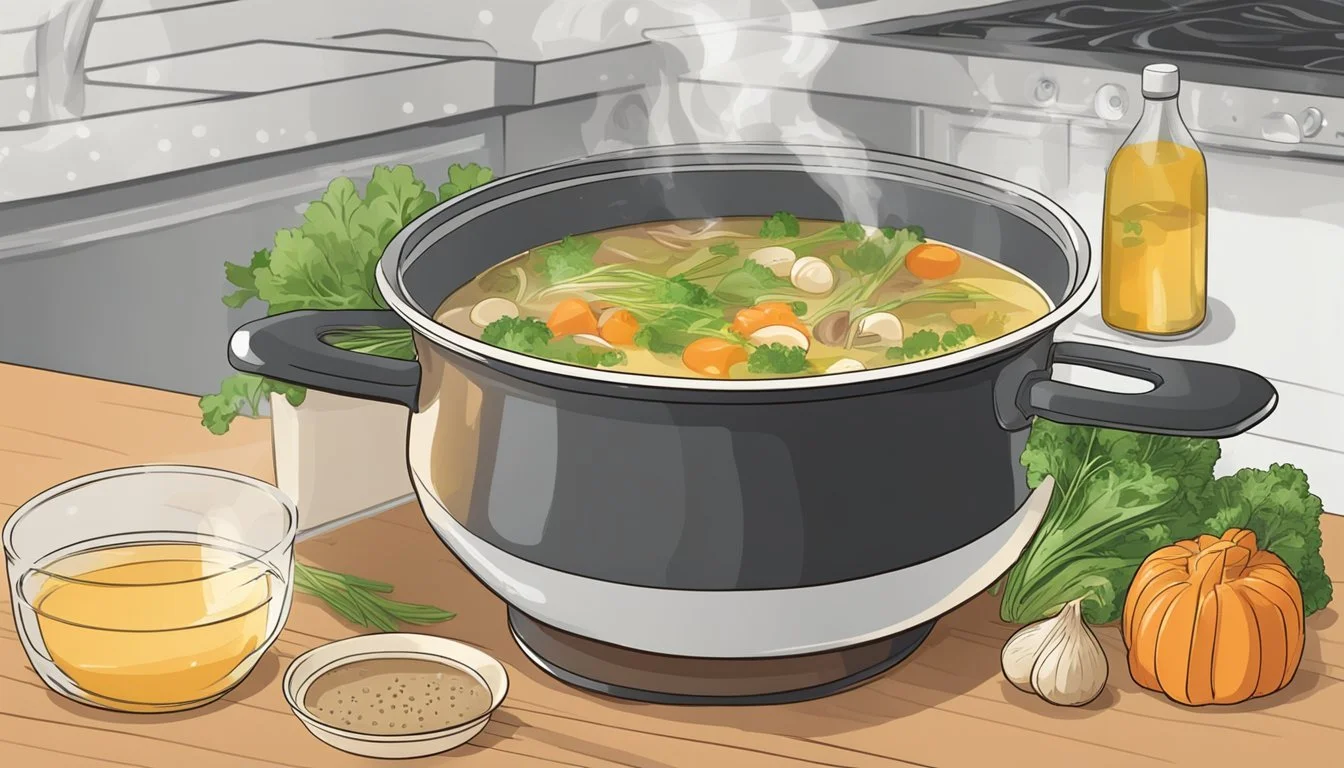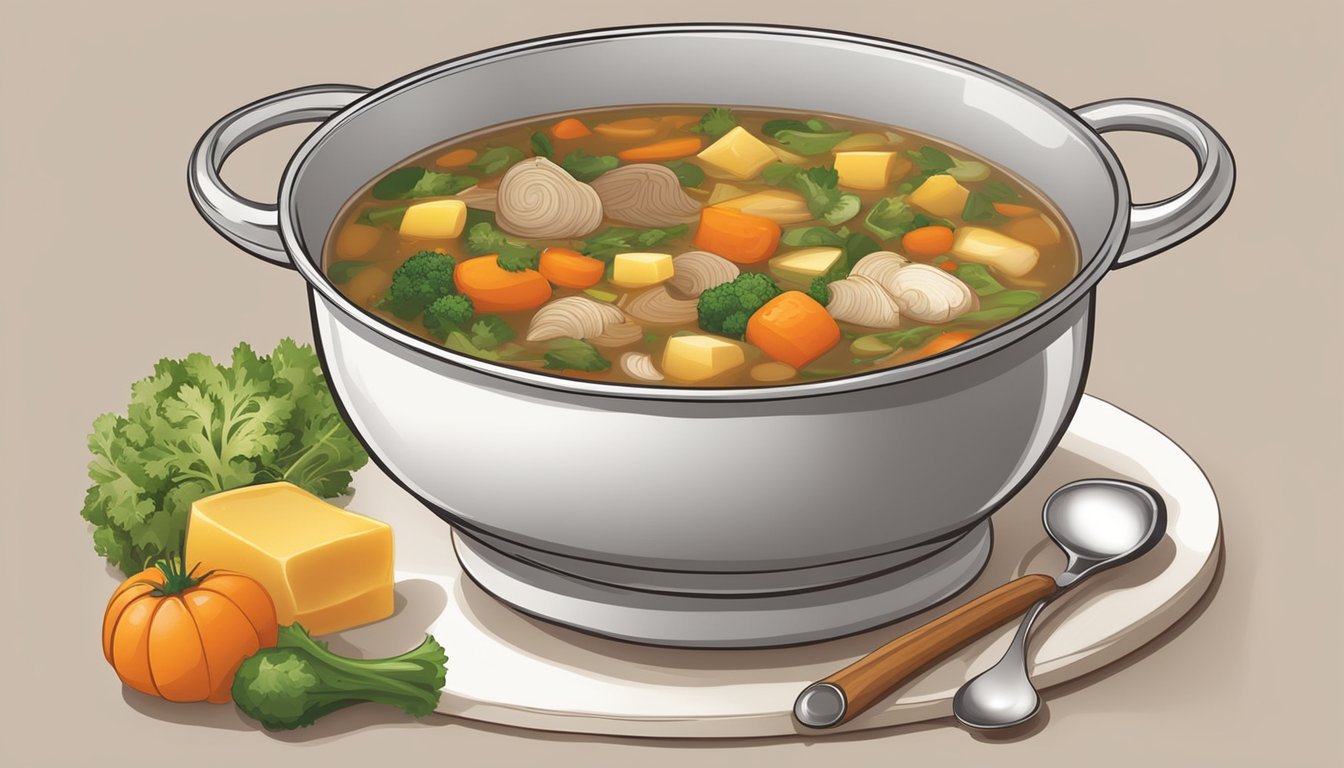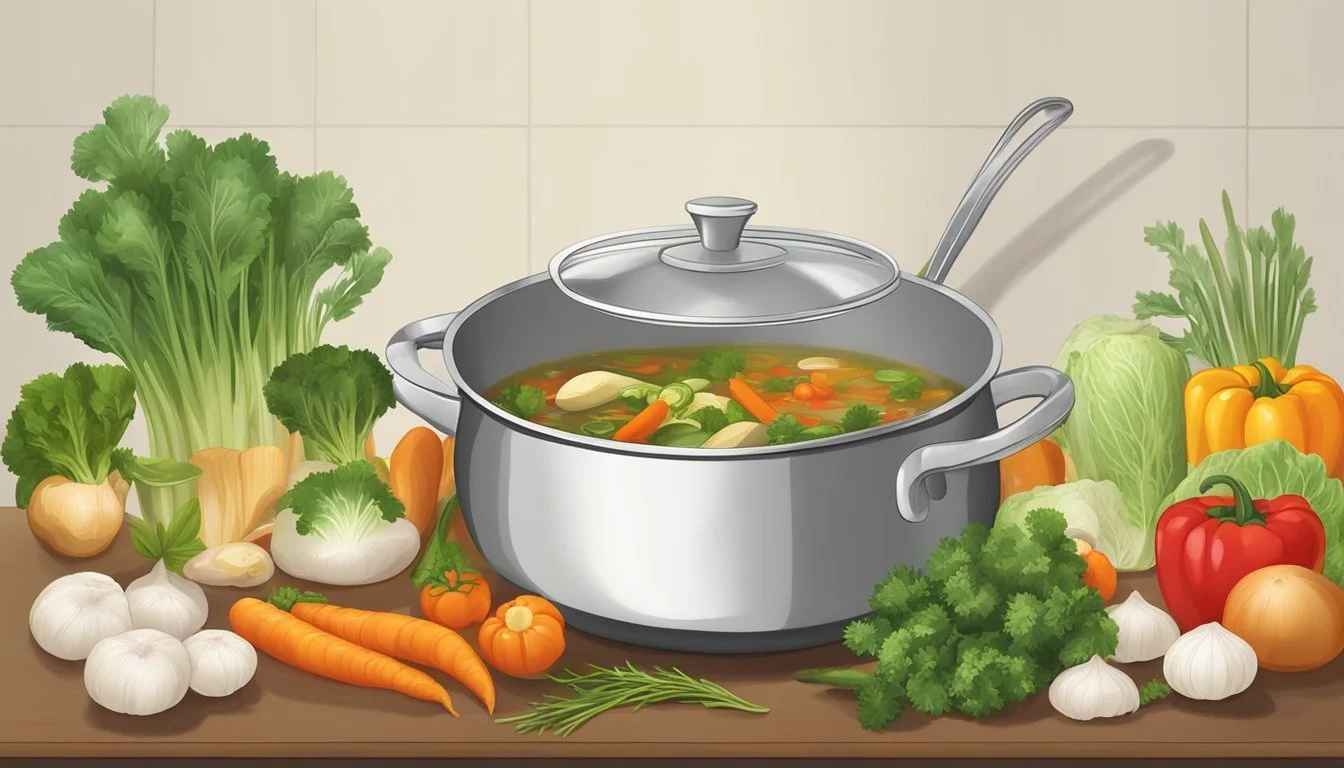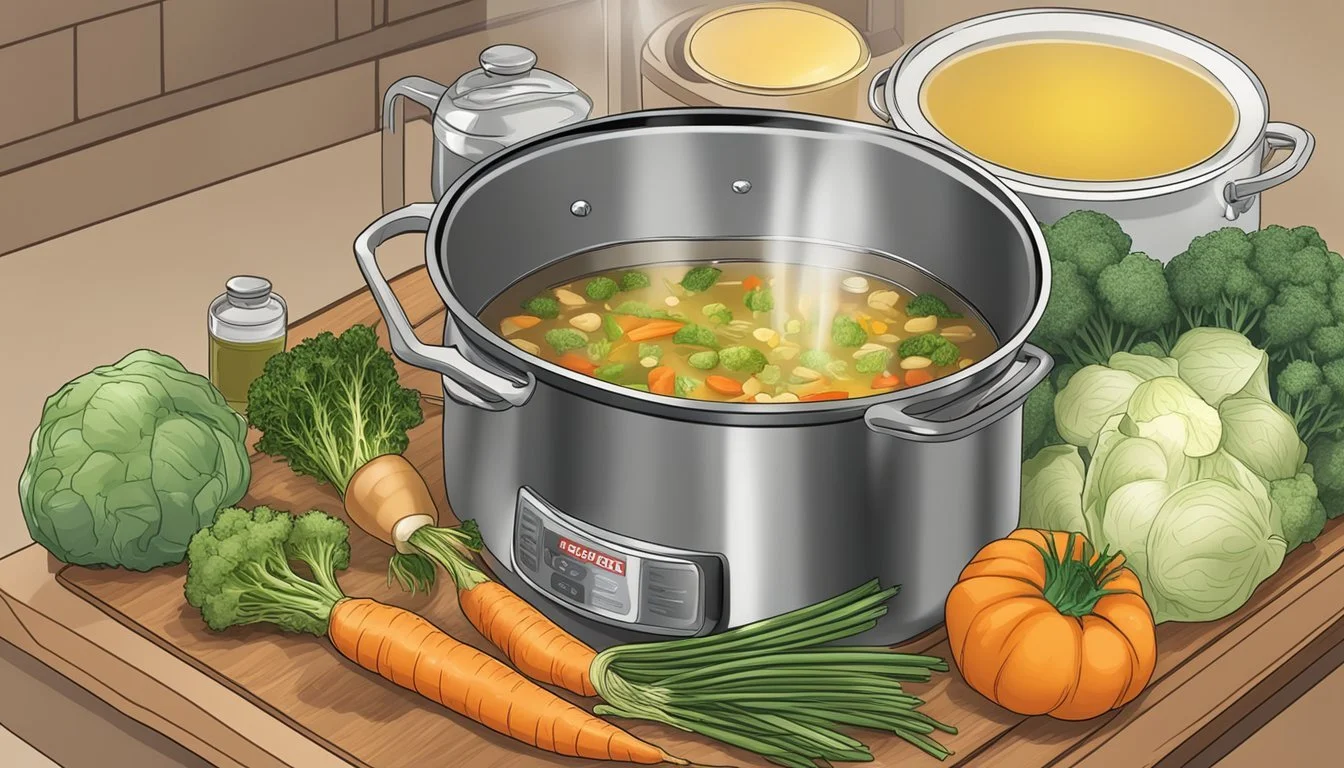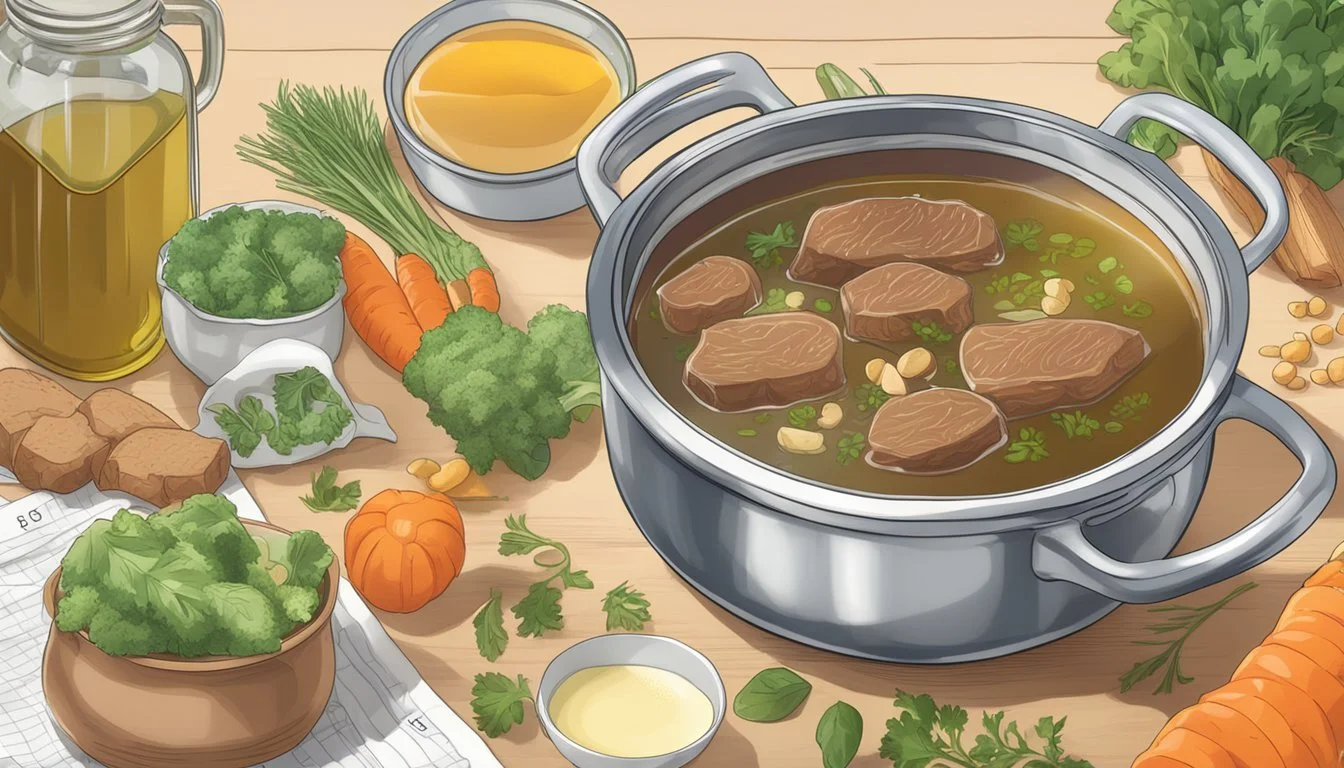How to Substitute Vegetable Broth for Beef Broth
A Seamless Swap Guide
Substituting vegetable broth for beef (What wine goes well with beef?) broth is a common practice for those looking to create a vegetarian or vegan version of a recipe that traditionally requires beef broth. Since beef broth has a rich, umami flavor profile that contributes to the depth of dishes, finding an appropriate substitution can be crucial to the success of the final dish. Vegetable broth offers a versatile base, providing a light and clean canvas to layer flavors upon, while also contributing its own subtle, earthy notes.
When replacing beef broth with vegetable broth, one must consider the distinctive taste and body that beef broth imparts to the recipe. Vegetable broth is often lighter, and to compensate for the difference, cooks may introduce umami-rich ingredients such as mushrooms (What wine goes well with mushrooms?) or miso paste. These additions can help bridge the flavor gap, creating a hearty and satisfying alternative to beef broth. Additionally, the use of aromatic vegetables and careful seasoning with herbs and spices can enhance the vegetable broth, enriching the recipe.
The key to successfully using vegetable broth as a substitute for beef broth lies in balancing flavors to achieve a result that satisfies the expectations of the dish. While the end result will undoubtedly differ from the original, it can still provide a pleasing and rich culinary experience. Cooks may even find that the lighter quality of vegetable broth allows for the nuances of other ingredients to shine through, offering a different, yet equally tasty, dimension to the recipe.
Understanding Broths and Stocks
Navigating through the world of broths, stocks, and consommés can be complex due to their subtle differences and varied uses in cooking. This section will elucidate key distinctions and properties of broths and stocks, focusing particularly on beef and vegetable varieties.
Differences Between Broth, Stock, and Consommé
Broth: Typically made by simmering meat and vegetables, sometimes with bones, seasoned with herbs and spices.
Stock: Generally prepared by simmering bones, possibly with a small amount of meat attached, with vegetables and seasoning. Stock often has a fuller flavor and thicker consistency due to gelatin released from long-simmered bones.
Consommé: A clarified broth that has been concentrated and refined to be clear and free from impurities. It is often richer and more intense in flavor than its base broth.
Beef Broth Characteristics
Beef broth, which is hearty and robust, is made by simmering beef, vegetables, and seasonings. The presence of meat imbues it with a strong flavor profile that is noticeably rich, with underlying notes imparted by the seasoning. Beef broth, unlike beef stock, typically has a lighter body as it does not emphasize gelatin extraction from bones.
Vegetable Broth Basics
Vegetable broth is composed primarily of vegetables and water. It can offer a flavorful alternative suitable for vegetarian and vegan recipes while being lighter in mouthfeel. A medley of vegetables is simmered with seasoning and sometimes, vegetable peels or stems to add depth. The character of vegetable broth can vary greatly depending on the type and proportion of vegetables and herbs used.
Substitution Fundamentals
When substituting vegetable broth for beef broth, it's crucial to balance flavor profile, adjust seasoning accurately, and understand the role each broth plays in recipes.
Flavor Profile Considerations
Vegetable broth offers a lighter taste and can vary in flavor based on its components. It typically lacks the rich, meaty umami flavor inherent in beef broth. To approximate the depth of beef broth, consider incorporating ingredients known for their umami such as mushrooms, tomatoes, or soy sauce into the vegetable broth. This creates a more complex base that better mimics the savory notes of beef broth.
Substituting Vegetable Broth in Recipes
In most recipes, vegetable broth can directly replace beef broth at a 1:1 ratio. This substitution works well for soups, stews, and sauces where beef broth acts as a background note rather than the primary flavor. For dishes where meaty flavor is critical, the cook may need to add additional seasonings to bridge the gap left by removing the beef broth.
Substitution Ratio:
Beef Broth Vegetable Broth Substitute 1 cup 1 cup Vegetable Broth
Adjusting Seasoning and Salt Levels
Beef broth typically has a higher sodium content compared to most homemade or store-bought vegetable broths. After substituting, taste the dish and adjust the salt level as needed to reach the desired flavor intensity. A judicious addition of salt or seasonings like garlic or onion powder can help heighten the dish’s overall savoriness without overshadowing the inherent flavors of the other ingredients.
Alternative Beef Broth Substitutes
When substituting vegetable broth for beef broth, one might seek richer flavors to mimic the beef's umami and depth. The following alternatives can enhance dishes with complexity akin to beef broth.
Using Chicken Broth
Chicken broth serves as a versatile substitute, lending a mild, savory flavor to dishes. It's lighter than beef broth but can be fortified by simmering with herbs and a mirepoix—carrots, celery (how long does celery last?), and onions. (What wine goes well with onions?) To substitute, use a 1:1 ratio.
Liquid Aminos and Soy Sauce
Both liquid aminos and soy sauce are known for their umami quality. They can provide a depth of flavor reminiscent of beef broth. Use these condiments in moderation due to their strong taste and high sodium content. A mixture diluted with water can serve as a beef broth stand-in, utilizing a 1:1 ratio for the total liquid volume.
Worcestershire Sauce and Steak Sauce
A blend of Worcestershire sauce and steak sauce can emulate the tangy and savory notes of beef broth. This is ideal for adding a complex flavor profile to dishes requiring a more nuanced taste. Typically, a few tablespoons per cup of water will suffice, adjusted to personal preference.
Mushroom Broth and Miso Paste
Mushroom broth carries an earthy taste that closely resembles beef broth and works well as a vegetarian replacement. Adding miso paste can further enhance the broth's richness, making a vegan-friendly alternative. Combine the mushroom broth with a small amount of miso paste, stirring until dissolved, to achieve the desired richness.
Beer and Wine Alternatives
Beer, notably non-alcoholic beer, and wine can add a depth and character to dishes, similar to beef broth. They should be used sparingly and generally in cooked dishes where the alcohol cooks off. Substitute equal amounts of beer or wine for beef broth, keeping in mind the overall flavor they bring to the dish.
Special Considerations for Soups and Stews
When substituting vegetable broth for beef broth, chefs must consider how to sustain the complexity, traditional flavors, and accommodate dietary needs without compromising the essence of soups and stews.
Creating Depth of Flavor
In soups and stews, beef broth contributes a rich, umami depth that vegetable broth may initially lack. To emulate this:
Herbs: Incorporate bay leaves and parsley during the simmering process to infuse earthy undertones.
Browning Vegetables: Sautéing onion, carrot, and celery before adding liquid can add a caramelized flavor.
Mushrooms: A broth made from mushrooms or the addition of dried mushroom powder can provide the savory quality typically found in beef broth.
Maintaining Traditional Tastes
It is essential to respect the original flavor profiles of traditional dishes.
Sauces: When making sauces conventional to specific cuisines, use vegetable broth subtly, so it doesn't overpower key flavors.
For dishes like casseroles that hinge on the rich taste of beef, add a splash of soy sauce or Worcestershire sauce (for non-vegetarian recipes) for depth.
Adapting Recipes for Dietary Restrictions
Catering to dietary restrictions doesn't mean sacrificing taste in soups and stews.
For a vegetarian or vegan variant, ensure all substitutes, like bouillon cubes, align with dietary needs.
Gluten-free: Confirm that any added thickening agents, such as flour, are replaced with gluten-free alternatives like cornstarch or a rice flour roux.
Ramen Seasoning: In Asian-inspired dishes including ramen, replace traditional beef seasoning packets with vegetable-based miso or homemade seasoning blends geared towards vegetarians.
Health and Nutrition Factors
When substituting vegetable broth for beef broth, one must consider the nutritional differences, such as sodium levels and protein content, as well as the unique health benefits each offers.
Sodium Content in Broths
Beef broth is often high in sodium, which can contribute to increased blood pressure and other health risks if consumed excessively. The American Heart Association recommends no more than 2,300 milligrams a day and moving toward an ideal limit of no more than 1,500 mg per day for most adults. In contrast, vegetable broth can be made with less sodium, providing a healthier alternative for those monitoring their sodium intake.
Beef Broth Sodium: Typically contains between 800-900 mg per cup.
Vegetable Broth Sodium: Varies; low-sodium options can contain as little as 140 mg per cup.
Collagen and Protein Considerations
Beef broth contains collagen, which comes from boiled bones and connective tissues, and it contributes to the broth's protein content. Collagen has potential benefits for skin, joint health, and gut healing. Vegetable broth, while not a source of collagen, can still be a good source of protein when it includes protein-rich vegetables like peas or spinach. One must consider alternative sources of collagen or protein if they rely on vegetable broth to meet their dietary needs.
Collagen in Beef Broth: Derived from animal bones and tissues.
Protein in Vegetable Broth: Dependent on the included vegetables' protein content.
Vegetable Broth Health Benefits
Vegetable broth is rich in vitamins and minerals, providing an array of health benefits. It typically contains a variety of vegetables like carrots, onions, and celery, which contribute nutrients that can support a healthy immune system and overall well-being. Vegetable broth can be a vital part of a balanced diet, particularly for vegetarians and vegans looking for nutrient-dense food options.
Vitamins in Vegetable Broth: Often high in vitamins A and C, as well as other antioxidants.
Overall Health: Can support a healthy diet, especially important for those not consuming meat products.
Homemade Broth Preparation
Preparing homemade broth ensures control over flavor and ingredients, making it a healthier alternative to store-bought options. This section offers insights on crafting a vegetable broth that mirrors the richness of beef broth, using simple ingredients like vegetables, herbs, and other kitchen staples.
Making Vegetable Broth at Home
Homemade vegetable broth serves as a versatile base for numerous dishes. To prepare it, one should simmer a variety of vegetables such as carrots, celery, onion, and garlic in water. Adding parsley, mushrooms, and any available vegetable scraps enhances the broth's complexity. The process usually takes 1-2 hours, allowing flavors to fully develop. Strain the broth to remove solids, retaining the flavorful liquid.
Ingredients:
4 cups water
2 carrots, chopped
2 celery stalks, chopped
1 large onion, chopped
2 garlic cloves, minced
Handful of parsley
1 cup mushrooms, chopped
Salt and pepper to taste
Steps:
Combine all ingredients in a large pot.
Bring to a boil, then reduce heat to a simmer.
Cover and simmer for 1-2 hours.
Strain and use or store for later.
Creating Beef-like Flavor Without Beef
To mimic the depth of beef broth without using meat, one can incorporate soy sauce, tomato paste, or beef bouillon cubes for umami richness. Use vegetables that offer meaty flavors, like mushrooms, and consider roasting vegetables prior to simmering to intensify their flavors. Experiment with small quantities of beef base or bouillon cubes to achieve the desired intensity.
Beef-like flavor enhancers:
Soy sauce
Tomato paste
Beef bouillon cubes
Beef base
Utilizing Leftover Vegetables and Herbs
Making homemade broth is an excellent way to utilize kitchen leftovers. Save trimmings from vegetables like carrots, celery, and onions, along with fresh herb stems like parsley. These can be stored in the freezer until there's enough for a batch of broth. For added richness, one can clarify the broth using egg whites, which trap sediments and impurities when simmered, creating a clear, flavorful broth.
Tips for using leftovers:
Store vegetable trimmings and fresh herb stems in the freezer.
Use egg whites for clarification to achieve a clear broth.
Combine with fresh water and simmer to extract maximum flavor.
Cooking Techniques and Tips
Substituting vegetable broth for beef broth in recipes requires a few adjustments for flavor and usage. The following techniques ensure that the essential qualities of beef broth are adequately replicated using vegetable broth.
Deglazing with Vegetable Broth
Deglazing a pan is a method used to lift the browned bits of food from the bottom of the pan, often after browning meat or sautéing vegetables. When using vegetable broth as a substitute, one should pour it into the hot pan and scrape the pan's bottom gently with a wooden spoon. This technique not only cleans the pan but also infuses the broth with a depth of flavor that enriches dishes like French onion soup or gravies.
Thickening Soups and Sauces
Vegetable broth can be used to give soups a hearty base. To achieve a thicker consistency akin to that provided by beef broth, one may need to incorporate thickening agents such as a roux, which is a mixture of fat and flour cooked together. For clear soups that require a robust flavor, reducing the vegetable broth by simmering can concentrate its taste. Additionally, incorporating aromatic vegetables and herbs into the broth can enhance its flavor profile.
Using Broth in Slow Cooker and Casserole Dishes
In slow cooker and casserole dishes, such as barley or rice casseroles, beef broth is often included for its savory richness. To substitute with vegetable broth, one should use a 1:1 ratio. The broth may be diluted if necessary, depending on the recipe's requirement. For grains, stuffing, and dishes that are served with au jus, ensuring the vegetable broth is well-seasoned will suitably complement the other ingredients.
Storing and Preserving Broths
Preserving the quality and extending the shelf life of homemade beef or vegetable stocks ensures they are available for future cooking needs. Proper storage techniques are key.
Maximizing Shelf Life of Broths
To maximize the shelf life of homemade broth, one should cool the broth quickly after it's cooked and store it in the refrigerator. Beef or vegetable stock should be kept in airtight containers and can be refrigerated for up to 3-4 days. For longer storage, one might add a thin layer of fat on top of the broth before refrigerating, which acts as a seal to keep out air.
Refrigerator: 3-4 days for optimal freshness
Airtight containers: Essential for refrigeration
Fat layer: Can act as a seal if used
Freezing and Re-using Broth
Freezing broth extends its usage period significantly. Homemade beef or vegetable stock can be frozen by pouring the broth into ice cube trays or freezer bags.
Ice cube trays: Convenient for small amounts, use within 6 months
Freezer bags/containers: Can be filled and laid flat to save space, use within 4-6 months
When re-using frozen broth, one should thaw it in the refrigerator overnight or use the defrost setting on a microwave. Reheated broth should always be brought to a full boil before consumption or use in recipes.
Final Thoughts on Broth Substitution
When substituting vegetable broth for beef broth, one should consider the dish's flavor profile. While vegetable broth offers a lighter, often more herbaceous character, it may lack the depth and meaty notes provided by beef broth. Achieving the proper balance of savory flavor requires attention to the intensity of the substitutes used.
For dishes that depend on a rich, beefy flavor, one can introduce an umami element with options like soy sauce, Worcestershire sauce, or even mushrooms to impart a more robust taste. This will not only enhance the savory quality but also contribute to the complexity of the dish.
If the recipe benefits from a slightly acidic component, consider the inclusion of tomato paste or wine, which can add depth while bringing some of the acidic notes that beef broth naturally possesses.
Suggested Vegetable Broth Substitutes for Beef Broth:
Soy sauce: Start with a small amount and adjust for taste.
Worcestershire sauce: Adds depth; use sparingly due to its strong flavor.
Mushrooms: Roasted or sautéed, mushrooms give a meaty texture and taste.
When replacing beef broth with vegetable broth, the key is to ensure that the dish maintains its intended appeal. One might need to adjust spices and seasonings to compensate for these changes.
In conclusion, the artisan of the kitchen must adapt the choice of vegetable broth substitute according to the specific requirements of their dish, always aiming to achieve a harmonious and flavorful result.


